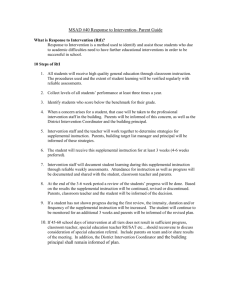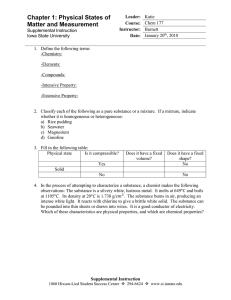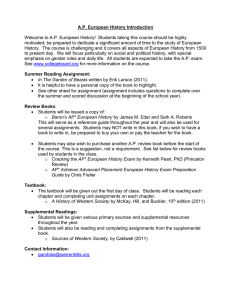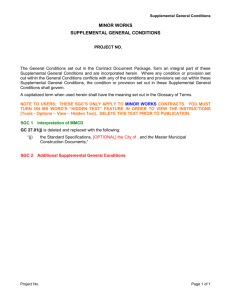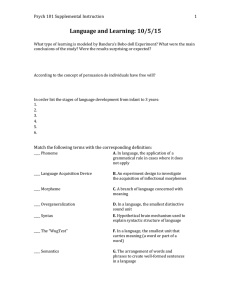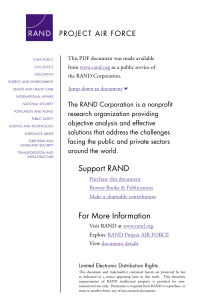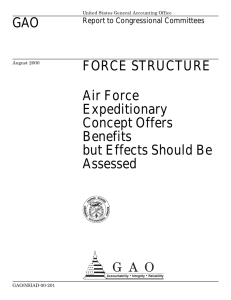DEPARTMENT OF THE AIR FORCE PRESENTATION TO THE SUBCOMMITTEE ON READINESS
advertisement
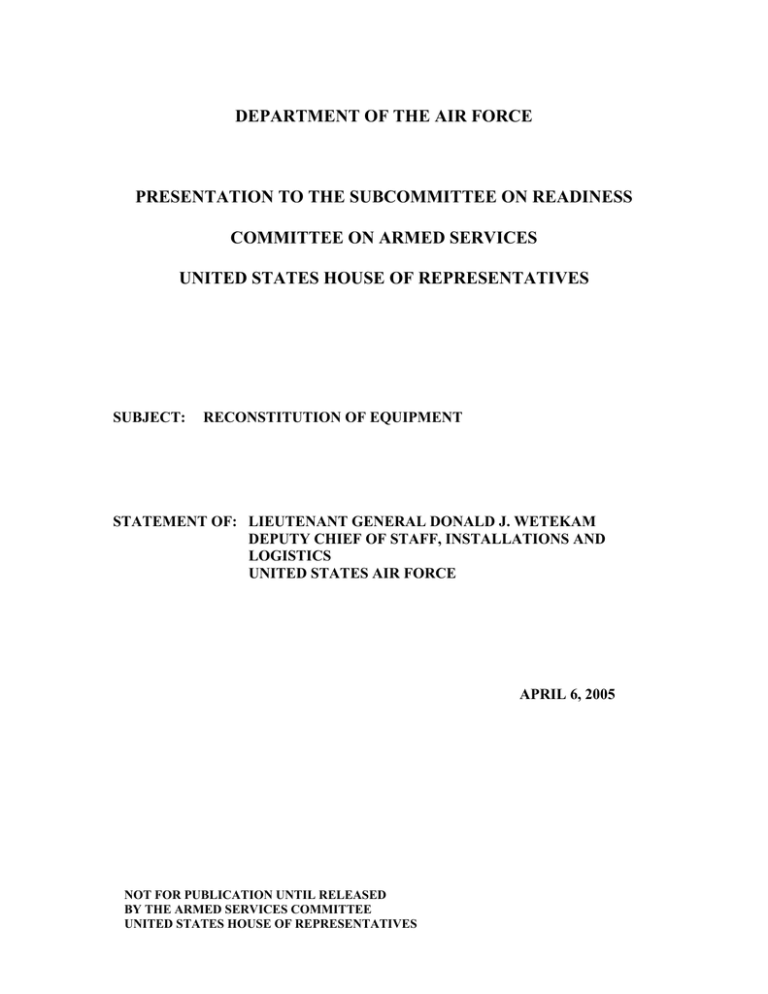
DEPARTMENT OF THE AIR FORCE PRESENTATION TO THE SUBCOMMITTEE ON READINESS COMMITTEE ON ARMED SERVICES UNITED STATES HOUSE OF REPRESENTATIVES SUBJECT: RECONSTITUTION OF EQUIPMENT STATEMENT OF: LIEUTENANT GENERAL DONALD J. WETEKAM DEPUTY CHIEF OF STAFF, INSTALLATIONS AND LOGISTICS UNITED STATES AIR FORCE APRIL 6, 2005 NOT FOR PUBLICATION UNTIL RELEASED BY THE ARMED SERVICES COMMITTEE UNITED STATES HOUSE OF REPRESENTATIVES Introduction Chairman Hefley, Congressman Ortiz, and distinguished members of the committee, thank you for the opportunity to appear before you to present the status of the Air Force requirements to reconstitute equipment returning from Operations Enduring Freedom (OEF) and Iraqi Freedom (OIF). As the Air Force Deputy Chief of Staff for Installations and Logistics, it is my privilege to report on our reconstitution efforts, our successes and our challenges for the future. On behalf of Acting Secretary Dominguez and General Jumper, thank you for your continued, strong support of the Air Force. Air and Space Expeditionary Force The Air Force organizes, trains, equips and sustains its forces to meet expeditionary operations commitments through the deployment and employment of Air and Space Expeditionary Forces (AEF). The AEF construct was based on our experiences in Desert Shield and Desert Storm and subsequent operations, and meets the requirements outlined in the National Military Strategy and the Strategic Planning Guidance. Consequently, the Air Force is divided into 10 AEFs grouped into pairs, and includes an Enabler Force to support and sustain global expeditionary operations. To enable the Air Force’s AEF construct, the Air Force logistics system is structured and sized to meet the needs of the AEF construct and maintain a surge capability. This installations and logistics (Agile Combat Support Concept of Operations) capability was developed, sized and field tested throughout the 1990s by sustained operations around the world, to include the Balkans, and Operations Southern and Northern Watch. With each operation, the AEF and the supporting logistics system demonstrated they were sized appropriately and flexible enough to meet evolving capability requirements. 1 The foundation of the Air Force logistics system is comprised of our public depots and the private sector industrial base. Both are synchronized with the AEF battle rhythm and the warfighter’s requirements. In addition to meeting requirements such as core and 50/50, we have undertaken a series of initiatives such as public/private partnering that serve the Air Force and the National Military Strategy well. The partnership of the public and private sectors is instrumental in meeting the needs of our day-to-day expeditionary operations while the public depots maintain surge capability to meet demands during periods of high ops tempo. In addition to our depot and industrial base sizing, the logistics community engages in a comprehensive strategy of pre-positioning War Reserve Material (WRM) around the world. Air Force munitions stored on pre-positioned ships around the globe is just one example of the Air Force’s rapidly deployable, flexible and Agile Combat Support system. Ammunition is not the only commodity that must be pre-positioned. WRM is stored in targeted locations for contingency use. The Air Force uses flexible contracts not only for the storage but also for the sustainment of such equipment. These scalable contracts were executed during OIF and OEF and have proven to be quite effective. The AEFs and their supporting logistics system have been tested for almost 15 years and have proven to be adaptable, flexible and most importantly, effective in accomplishing the Air Force’s many missions. The rotation cycle inherent in the AEF complements this by allowing for the logistics system to reconstitute equipment and capabilities, and make units ready for the next deployment in a measured way. In summary, the AEFs have served the Nation well and we will continue to use the AEF construct to organize, train, equip and sustain our forces for the foreseeable future. 2 Success Stories The Air Force has experienced many successes throughout OIF and OEF. We flew over 250,000 sorties, opened 36 bases and maintained 31,000 Airmen in the Area of Responsibility (AOR). Additionally, since September 2001, our mobility forces moved over 1.4 million troops and delivered more than 2,200 tons of humanitarian daily rations for OIF and OEF. Our Airmen have been busy and successful. Of course, these successes are not only the result of Air Force efforts. Congressional help was and is key to providing the funding necessary for force protection, to replenish or replace equipment and commodities lost in combat, and to reconstitute critical capabilities for the combatant commanders. In aggregate, the FY04 supplemental provided $354 million for reconstituting stressed equipment and the FY05 submission requests $826 million for the same. Supplemental funding helps provide the best and latest equipment to protect our Airmen while they are in harm’s way. Funding in FY04 and FY05 will provide over $140 million to equip four AEFs and the deployed Enabling Forces with body armor. FY05 supplemental funding will also provide reconstitution for equipment that was lost in combat. Over $15.9 million in the FY04 supplemental and over $10 million requested in FY05 will reconstitute vital Explosive Ordnance Destruction (EOD) munitions and robots. Up-armored High Mobility Multipurpose Wheeled Vehicle (HMMWV) supplemental dollars fund badly needed protective vehicles for our Airmen in the AOR. Twenty-one million dollars in FY04 funding was provided to buy 127 up-armored HMMWVs and we have requested another $8.6 million for an additional 46 vehicles in the Air Force’s FY05 supplemental. During OIF and OEF, the Air Force opened up 36 bases, 15 of which are still open, with Basic Expeditionary Airfield Resource (BEAR) kits. Congress’ support of the 3 FY03 supplemental provided $330 million for new procurement and replacement of these critical BEAR assets—a capability vital to AEF employment. Global War on Terrorism (GWOT) funding effectively addressed stress on equipment existing in theater due to aging, wear and tear, and combat loss. Sustainment costs in theater were also well funded. Continued Congressional support was critical to restoring capabilities eroded by our deployed operations. Continuing Challenges No success comes without challenges, especially in a rapidly evolving combat environment involving multiple locations worldwide. The cost of resetting the force continues to increase with each passing year of the Global War on Terrorism. Supplemental funding plugged some holes by reconstituting capabilities and covering the O&M increases for our in-theater maintenance requirements. The Air Force works hard at programming for WRM replenishment and reconstituting and pre-positioning equipment. In fact, we programmed close to $1 billion for operations and maintenance of vehicle and support equipment WRM and almost $270 million for munitions across the Future Year Defense Program. Additionally, we are ensuring we reconstitute capabilities and not just equipment. One example is Fuels Operational Readiness Capability Equipment (FORCE), which is replacing our current deployable fuel storage capability. Our current deployable Vietnam-era Fuels Mobility Support Equipment (FMSE) performed poorly in OIF. FORCE’s new modular design reduces the logistics footprint and manpower while it increases throughput and effectiveness at US bases, allied bases, civil airports and captured airfields. The Air Force programmed $87.1 million through FY11 to purchase these highly capable FORCE sets. One of our biggest challenges in the Air Force is the need to recapitalize and reconstitute our aging aircraft. Aging aircraft continues to increasingly stress our 4 maintenance personnel, supply systems, and our depots and the defense industrial base. At the start of Operations Desert Shield and Desert Storm, the average age of our aircraft was 17 years. Only 10 years later, at the start of OIF and OEF, our average aircraft age was 22. The Air Force has chartered a Fleet Viability Board that conducts continuous fleet assessments to determine the viability of our aging weapons systems. This assessment will ensure the Air Force transforms its force structure while maintaining an acceptable level of risk. Our budget submissions include funding required to recapitalize and modernize our equipment as we continue to fly our aging aircraft and bring on future systems. Critical to maintaining and operating our aging aircraft is Depot Purchased Equipment Maintenance (DPEM) funding. Congress was instrumental in providing needed DPEM supplemental funding in FY03 and FY04. The FY05 supplemental submission requests $183 million to produce 23 aircraft and 15 engines through programmed depot maintenance as well as to fund $22 million in software programming. Additionally, the Air Force continues to experience extensive corrosion and damage due to harsh operating environment and increased ops tempo. DPEM will continue to be an area requiring strong fiscal support as we continue our focused reconstitution efforts. As we look at reconstituting our capabilities for the future, we must remember that 25 percent of the air expeditionary forces are composed of Air National Guard and Air Force Reserve units and personnel. Guard and Reserve equipment is especially stressed by ongoing operations in the GWOT. We are continually looking for ways to operate in a more integrated and seamless manner, and programmed so that reconstitution and pre-positioning of equipment are addressed as a team requirement across the total force. 5 Summary As we employ our Air and Space Expeditionary Forces we must reconstitute not only our equipment, but we must also reconstitute our capabilities—if not also develop new ones. By doing so, the Air Force is prepared to fight today’s war, as well as tomorrow’s. Strong, timely Congressional support has ensured that reconstitution and pre-positioning of equipment has been funded through the normal budget process but also through much-needed supplementals. The Air Force will continue to emphasize reconstitution and pre-positioning of equipment in our budget submissions as a part of sustaining required capabilities and maintaining our needed readiness posture. Your support in reconstituting the Air Force, as well as the other Services, has been vital in giving our nation’s warfighters the capabilities they need to defend the United States and defeat our enemies. Chairman Hefly, Congressman Ortiz, and members of the committee, on behalf of our nation’s Airmen, thank you for your continuing support. 6




